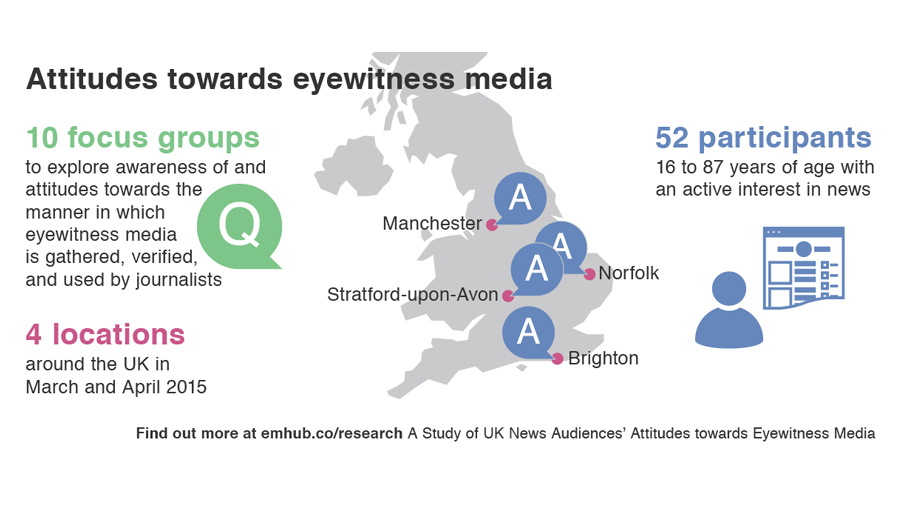Abstract
Following our two recent research studies exploring how some of the most popular online newspaper sites and TV broadcasters use Eyewitness Media, we set out to better understand the attitudes of news audiences.
We wanted to know what qualities they believe eyewitness media brings to news output, their attitudes towards the importance of verifying, crediting and labelling such content, and how they feel about the process through which journalists seek permission from users who have shared photographs and videos online.
We conducted 10 focus groups in various locations around the UK, including participants whose ages ranged from 16 to 87. All participants were chosen on the basis of having an active interest in the news.
Introduction
The phenomenon of people using smartphones and other portable devices to capture and share newsworthy moments is inescapable. From the shocking images of people desperately trying to escape a sinking dinghy in the middle of the Mediterranean to Paul Nolan’s video of Chelsea supporters racially abusing Souleymane S on the Paris Métro to activist footage documenting the ongoing atrocities in Syria and Iraq, this content, captured by people unattached to the newsroom, has become a cornerstone of the contemporary news landscape.
The phenomenon of eyewitness media has blurred the line between news audiences and news producers. Rapid advancements in mobile technology, coupled with the proliferation of social media platforms such as Facebook, Twitter, Instagram, and, more recently, Periscope and Meerkat, mean that anyone armed with a smartphone has the capacity to document and broadcast events in a way that was previously the exclusive realm of professional journalists. Despite resistance in some quarters, there is no denying the impact eyewitness media have had on the news industry in recent years. As Richard Porter, controller of BBC World (English), put it, this content ‘has become a central element of the newsgathering process now. No question about that’ (quoted in Wardle et al., 2014b: 21).
While much has been made of the extent to which eyewitness media has infiltrated news output and the impact they have had on professional journalists’ workflows, relatively little is known about news consumers’ attitudes towards this content.
The purpose of this research is to explore knowledge of and attitudes towards eyewitness media among UK news audiences. It was designed to answer six research questions:
1. What qualities do UK audiences believe eyewitness media bring to news output?
2. What are UK audiences’ attitudes towards the importance of verifying eyewitness media?
3. What are UK audiences’ attitudes towards the importance of crediting eyewitness media?
4. To what extent do UK audiences feel news organisations have an obligation to label eyewitness media?
5. What are UK audiences’ attitudes towards the process through which journalists seek permission to use eyewitness media on social media?
6. What reservations do UK audiences have about eyewitness media in the news?
These questions were designed to examine the same areas of eyewitness media as were explored in our earlier studies of journalists’ production processes/workflows (Wardle et al., 2014b) and output (Brown, 2015; Wardle et al., 2014a), thereby completing the trinity of production, content, and reception. To address these questions we conducted 10 focus groups in various locations around the UK, including participants whose ages ranged from 16 to 87. These proved so fruitful that, despite originally planning to conduct 12 focus groups, we took the decision to stop after 10 as we felt we had reached ‘theoretical saturation’, i.e. the point at which ‘comments and patterns began to repeat and little new material was created’ (Livingstone and Lunt, 1993: 181, see also Bryman, 2012).
The findings outlined in this report focus solely on the UK and are intended as a building block in our wider attempts to understand audience responses to eyewitness media. After all, eyewitness media is a global phenomenon. Even in countries where they have not necessarily penetrated the mainstream news media to the extent one might expect, such as India, for example (see Bélair‑Gagnon and Agur, 2013; Brown, 2015), it is predicted that this will soon change as mobile technology becomes more accessible and online infrastructures rapidly disseminate and improve (see e.g. Barot, 2014). In countries where it is already a mainstay, our earlier cross‐national work around content and production has highlighted numerous similarities in terms of how eyewitness media is gathered, handled, and used by international news outlets (see Brown, 2015; Wardle et al., 2014b). Thus, while we may hypothesise that there are likely to be similarities in audience members’ awareness of and attitudes towards eyewitness media across countries (particularly those where major news outlets make frequent use of this material, such as Australia, France, USA), it would be injudicious to make any such claims without supporting empirical evidence. Indeed, a cross‑national study of audience attitudes towards eyewitness media is an area in which future research would be hugely beneficial.
– For the methodology, findings and conclusions, see http://eyewitnessmediahub.com/research/uk-news-audience-attitudes
– Download a PDF of the report




